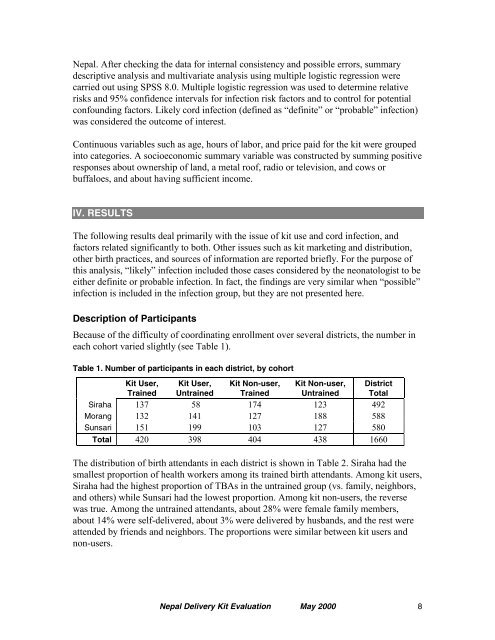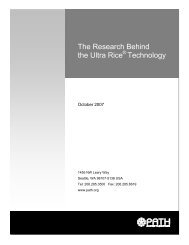Nepal Clean Home Delivery Kit: Evaluation of the Health Impact - Path
Nepal Clean Home Delivery Kit: Evaluation of the Health Impact - Path
Nepal Clean Home Delivery Kit: Evaluation of the Health Impact - Path
Create successful ePaper yourself
Turn your PDF publications into a flip-book with our unique Google optimized e-Paper software.
<strong>Nepal</strong>. After checking <strong>the</strong> data for internal consistency and possible errors, summary<br />
descriptive analysis and multivariate analysis using multiple logistic regression were<br />
carried out using SPSS 8.0. Multiple logistic regression was used to determine relative<br />
risks and 95% confidence intervals for infection risk factors and to control for potential<br />
confounding factors. Likely cord infection (defined as “definite” or “probable” infection)<br />
was considered <strong>the</strong> outcome <strong>of</strong> interest.<br />
Continuous variables such as age, hours <strong>of</strong> labor, and price paid for <strong>the</strong> kit were grouped<br />
into categories. A socioeconomic summary variable was constructed by summing positive<br />
responses about ownership <strong>of</strong> land, a metal ro<strong>of</strong>, radio or television, and cows or<br />
buffaloes, and about having sufficient income.<br />
IV. RESULTS<br />
The following results deal primarily with <strong>the</strong> issue <strong>of</strong> kit use and cord infection, and<br />
factors related significantly to both. O<strong>the</strong>r issues such as kit marketing and distribution,<br />
o<strong>the</strong>r birth practices, and sources <strong>of</strong> information are reported briefly. For <strong>the</strong> purpose <strong>of</strong><br />
this analysis, “likely” infection included those cases considered by <strong>the</strong> neonatologist to be<br />
ei<strong>the</strong>r definite or probable infection. In fact, <strong>the</strong> findings are very similar when “possible”<br />
infection is included in <strong>the</strong> infection group, but <strong>the</strong>y are not presented here.<br />
Description <strong>of</strong> Participants<br />
Because <strong>of</strong> <strong>the</strong> difficulty <strong>of</strong> coordinating enrollment over several districts, <strong>the</strong> number in<br />
each cohort varied slightly (see Table 1).<br />
Table 1. Number <strong>of</strong> participants in each district, by cohort<br />
<strong>Kit</strong> User,<br />
Trained<br />
<strong>Kit</strong> User,<br />
Untrained<br />
<strong>Kit</strong> Non-user,<br />
Trained<br />
<strong>Kit</strong> Non-user,<br />
Untrained<br />
District<br />
Total<br />
Siraha 137 58 174 123 492<br />
Morang 132 141 127 188 588<br />
Sunsari 151 199 103 127 580<br />
Total 420 398 404 438 1660<br />
The distribution <strong>of</strong> birth attendants in each district is shown in Table 2. Siraha had <strong>the</strong><br />
smallest proportion <strong>of</strong> health workers among its trained birth attendants. Among kit users,<br />
Siraha had <strong>the</strong> highest proportion <strong>of</strong> TBAs in <strong>the</strong> untrained group (vs. family, neighbors,<br />
and o<strong>the</strong>rs) while Sunsari had <strong>the</strong> lowest proportion. Among kit non-users, <strong>the</strong> reverse<br />
was true. Among <strong>the</strong> untrained attendants, about 28% were female family members,<br />
about 14% were self-delivered, about 3% were delivered by husbands, and <strong>the</strong> rest were<br />
attended by friends and neighbors. The proportions were similar between kit users and<br />
non-users.<br />
<strong>Nepal</strong> <strong>Delivery</strong> <strong>Kit</strong> <strong>Evaluation</strong> May 2000 8
















